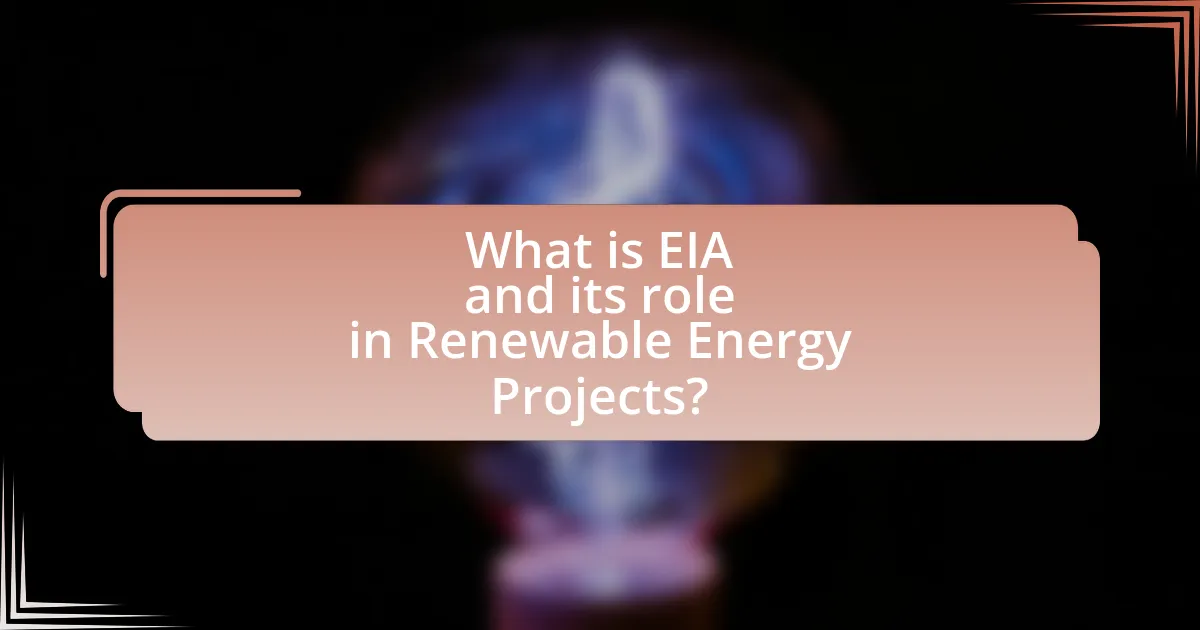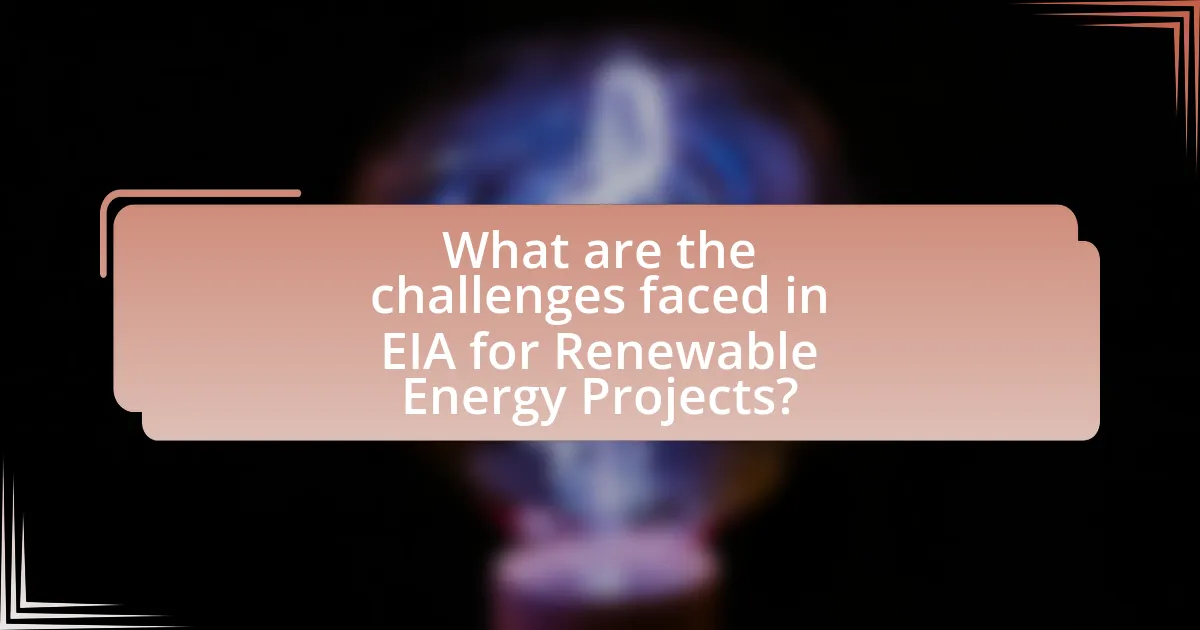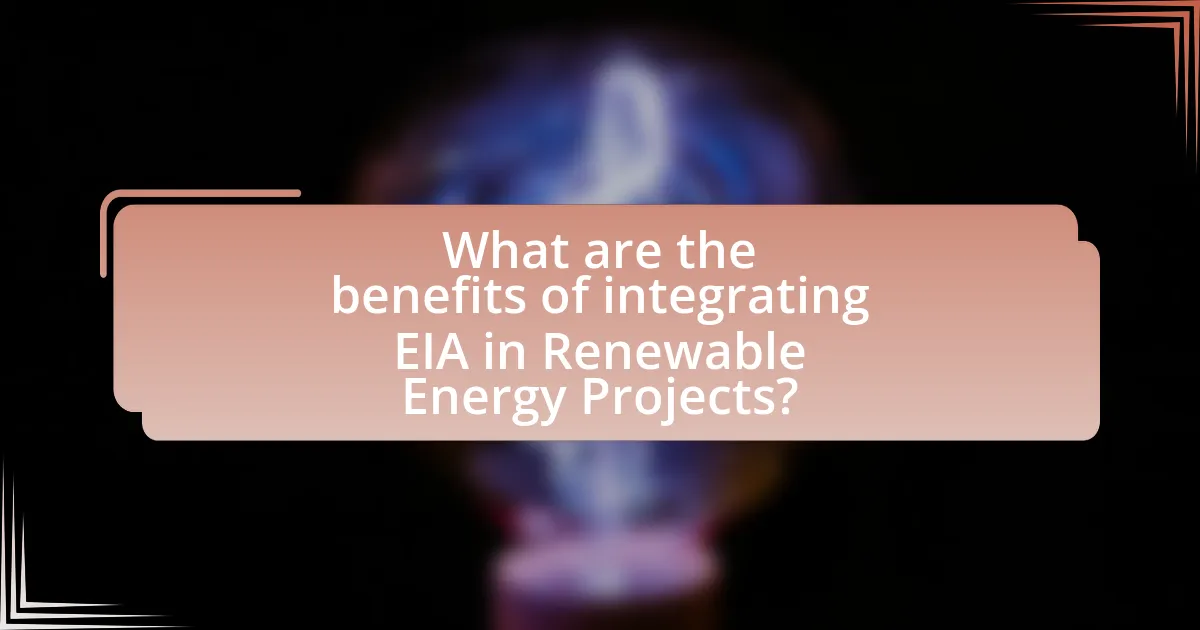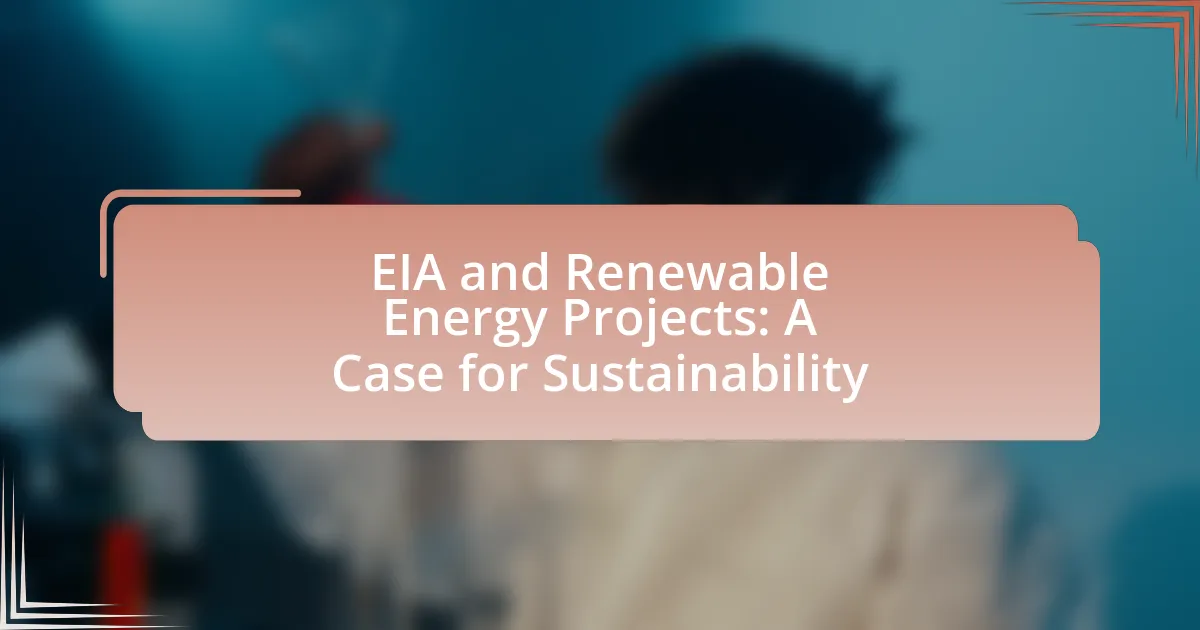Environmental Impact Assessment (EIA) is a critical process for evaluating the potential environmental effects of renewable energy projects. This article outlines the role of EIA in promoting sustainable development by identifying and mitigating adverse impacts before project implementation. It details the EIA process, including key stages such as screening, scoping, impact assessment, and stakeholder participation, while also addressing challenges faced in EIA implementation. Furthermore, the article highlights the benefits of integrating EIA into renewable energy initiatives, showcasing successful case studies and practical steps to enhance EIA effectiveness for better environmental outcomes.

What is EIA and its role in Renewable Energy Projects?
EIA, or Environmental Impact Assessment, is a systematic process used to evaluate the potential environmental effects of proposed projects, including renewable energy initiatives. Its role in renewable energy projects is crucial as it helps identify, predict, and mitigate adverse environmental impacts before project implementation. For instance, EIA ensures compliance with environmental regulations and promotes sustainable development by integrating environmental considerations into the planning and decision-making processes. Studies have shown that effective EIA can lead to better project outcomes, enhancing ecological protection while facilitating the transition to renewable energy sources.
How does the Environmental Impact Assessment process work?
The Environmental Impact Assessment (EIA) process works by systematically evaluating the potential environmental effects of proposed projects before they are approved. This process typically involves several key steps: screening to determine if an EIA is necessary, scoping to identify the relevant environmental issues, conducting an impact assessment to analyze potential effects, and preparing an Environmental Impact Statement (EIS) that outlines findings and proposed mitigation measures.
The EIA process is mandated by regulations in many countries, ensuring that decision-makers consider environmental impacts alongside economic and social factors. For instance, the National Environmental Policy Act (NEPA) in the United States requires federal agencies to assess environmental impacts for major projects. This structured approach helps to promote sustainable development by minimizing adverse environmental effects and fostering informed decision-making.
What are the key stages of the EIA process?
The key stages of the Environmental Impact Assessment (EIA) process include screening, scoping, impact assessment, mitigation, reporting, and monitoring. Screening determines whether a project requires an EIA, while scoping identifies the key issues and impacts to be assessed. The impact assessment stage evaluates the potential environmental effects of the project, followed by the development of mitigation measures to address significant impacts. Reporting involves compiling the findings into an EIA report, which is then reviewed by regulatory authorities. Finally, monitoring ensures compliance with the mitigation measures and assesses the effectiveness of the EIA process. These stages are essential for ensuring that environmental considerations are integrated into project planning and decision-making.
How do stakeholders participate in the EIA process?
Stakeholders participate in the Environmental Impact Assessment (EIA) process through various mechanisms, including public consultations, submission of comments, and involvement in decision-making. During the EIA process, stakeholders such as local communities, government agencies, and non-governmental organizations are invited to provide input on potential environmental impacts of proposed projects. This participation is often formalized through public meetings and hearings, where stakeholders can express concerns and suggest alternatives. The effectiveness of stakeholder participation is supported by regulations in many countries that mandate public involvement in the EIA process, ensuring that diverse perspectives are considered in project planning and decision-making.
Why is EIA important for sustainability in renewable energy?
EIA, or Environmental Impact Assessment, is crucial for sustainability in renewable energy because it systematically evaluates the potential environmental effects of energy projects before they are implemented. This process ensures that decision-makers consider ecological, social, and economic impacts, leading to more informed choices that promote sustainable development. For instance, a study by the International Association for Impact Assessment highlights that EIA can help identify and mitigate adverse effects on biodiversity and local communities, thereby enhancing the overall sustainability of renewable energy initiatives.
What are the potential environmental impacts of renewable energy projects?
Renewable energy projects can have several potential environmental impacts, including habitat disruption, land use changes, and resource consumption. For instance, the construction of wind farms can lead to the alteration of local ecosystems and displacement of wildlife, as evidenced by studies showing that wind turbines can affect bird and bat populations. Additionally, solar energy installations often require significant land areas, which can result in habitat loss, particularly in sensitive ecosystems. Furthermore, the production of renewable energy technologies, such as solar panels and wind turbines, involves the extraction and processing of raw materials, which can contribute to environmental degradation and pollution. These impacts highlight the importance of conducting thorough Environmental Impact Assessments (EIAs) to mitigate adverse effects and promote sustainable practices in renewable energy development.
How does EIA contribute to minimizing negative impacts?
EIA, or Environmental Impact Assessment, contributes to minimizing negative impacts by systematically evaluating the potential environmental effects of proposed projects before they are implemented. This process identifies significant environmental concerns, allowing project developers to modify plans to mitigate adverse effects. For instance, a study by the International Association for Impact Assessment found that projects subjected to EIA are 30% more likely to incorporate measures that protect biodiversity and reduce pollution compared to those that do not undergo such assessments. By facilitating informed decision-making, EIA plays a crucial role in promoting sustainable development and protecting ecosystems.

What are the challenges faced in EIA for Renewable Energy Projects?
The challenges faced in Environmental Impact Assessment (EIA) for Renewable Energy Projects include regulatory complexities, stakeholder engagement issues, and data limitations. Regulatory complexities arise from varying laws and guidelines across jurisdictions, which can lead to inconsistent EIA processes. Stakeholder engagement issues often stem from conflicting interests among local communities, environmental groups, and project developers, making consensus difficult. Data limitations refer to the lack of comprehensive environmental data, which can hinder accurate assessments of potential impacts. These challenges can delay project timelines and increase costs, ultimately affecting the feasibility of renewable energy initiatives.
What common obstacles hinder effective EIA implementation?
Common obstacles that hinder effective Environmental Impact Assessment (EIA) implementation include inadequate stakeholder engagement, lack of technical expertise, insufficient funding, and regulatory challenges. Inadequate stakeholder engagement often leads to a lack of local knowledge and community support, which can undermine the EIA process. A study by the International Association for Impact Assessment highlights that many EIAs fail due to insufficient involvement of affected communities, resulting in incomplete assessments. Lack of technical expertise can result in poorly conducted assessments, as many practitioners may not have the necessary training or experience. Insufficient funding limits the scope and depth of EIAs, making it difficult to conduct comprehensive studies. Regulatory challenges, such as unclear guidelines or conflicting policies, can create barriers to effective EIA implementation, as noted in research published by the World Bank, which emphasizes the importance of clear regulatory frameworks for successful EIA processes.
How do regulatory frameworks affect EIA processes?
Regulatory frameworks significantly influence Environmental Impact Assessment (EIA) processes by establishing the legal requirements and procedures that must be followed. These frameworks dictate the scope of assessments, the methodologies employed, and the stakeholder engagement necessary for compliance. For instance, in the United States, the National Environmental Policy Act (NEPA) mandates federal agencies to assess environmental effects before making decisions, thereby shaping the EIA process to ensure thorough evaluation and public involvement. Additionally, regulatory frameworks can set specific timelines and standards for reporting, which can either expedite or prolong the EIA process depending on the complexity of the project and the regulatory environment.
What role does public perception play in EIA challenges?
Public perception significantly influences Environmental Impact Assessment (EIA) challenges by shaping stakeholder engagement and decision-making processes. When the public perceives a project negatively, it can lead to increased opposition, protests, and demands for more rigorous assessments, ultimately delaying or halting projects. For instance, studies have shown that public opposition can result in legal challenges and additional regulatory scrutiny, as seen in the case of the Cape Wind project in Massachusetts, where local opposition led to prolonged delays and increased costs. Thus, public perception acts as a critical factor in determining the success or failure of EIA processes in renewable energy projects.
How can these challenges be addressed?
To address the challenges in Environmental Impact Assessments (EIA) for renewable energy projects, implementing a comprehensive stakeholder engagement process is essential. This approach ensures that the concerns of local communities, environmental groups, and other stakeholders are considered, leading to more informed decision-making. Research indicates that projects with robust stakeholder involvement tend to have higher acceptance rates and fewer conflicts, as evidenced by a study published in the Journal of Environmental Management, which found that inclusive processes significantly enhance project sustainability and community support. Additionally, integrating adaptive management strategies allows for ongoing assessment and adjustment of projects based on real-time environmental data, further mitigating potential negative impacts.
What best practices can improve EIA effectiveness?
To improve Environmental Impact Assessment (EIA) effectiveness, integrating stakeholder engagement throughout the process is essential. Engaging stakeholders, including local communities and experts, ensures diverse perspectives are considered, leading to more comprehensive assessments. Research indicates that projects with robust stakeholder involvement experience fewer conflicts and better project outcomes, as highlighted in the study “Stakeholder Engagement in Environmental Impact Assessment” by the International Association for Impact Assessment. Additionally, utilizing adaptive management practices allows for ongoing monitoring and adjustments based on environmental feedback, enhancing the EIA’s responsiveness to changing conditions. Implementing these best practices can significantly elevate the quality and effectiveness of EIAs in renewable energy projects.
How can technology enhance the EIA process?
Technology can enhance the Environmental Impact Assessment (EIA) process by improving data collection, analysis, and stakeholder engagement. Advanced tools such as Geographic Information Systems (GIS) enable precise mapping of environmental features, allowing for better spatial analysis of potential impacts. Additionally, remote sensing technologies provide real-time data on environmental conditions, which can be integrated into the EIA to assess changes over time. Furthermore, digital platforms facilitate communication among stakeholders, ensuring that public input is gathered efficiently and transparently. Studies have shown that incorporating these technologies can lead to more informed decision-making and ultimately more sustainable outcomes in renewable energy projects.

What are the benefits of integrating EIA in Renewable Energy Projects?
Integrating Environmental Impact Assessment (EIA) in Renewable Energy Projects enhances sustainability by identifying potential environmental impacts early in the project lifecycle. This proactive approach allows for informed decision-making, ensuring that projects minimize negative effects on ecosystems and communities. For instance, studies show that EIA processes can lead to better project design, which reduces habitat destruction and promotes biodiversity conservation. Furthermore, EIA fosters stakeholder engagement, improving public acceptance and support for renewable energy initiatives, as evidenced by increased community involvement in projects that undergo thorough assessments.
How does EIA promote sustainable development?
EIA, or Environmental Impact Assessment, promotes sustainable development by systematically evaluating the potential environmental effects of proposed projects before they are approved. This process ensures that decision-makers consider environmental, social, and economic factors, leading to more informed and responsible project planning. For instance, EIA requires public participation and stakeholder engagement, which helps identify local concerns and values, thereby fostering community support and minimizing negative impacts. Additionally, studies have shown that projects subjected to EIA are more likely to incorporate sustainable practices, as they are compelled to explore alternatives and mitigation measures that align with sustainability goals.
What are the long-term benefits of conducting EIA?
Conducting Environmental Impact Assessments (EIA) provides long-term benefits such as enhanced environmental protection, improved project sustainability, and increased public participation. These assessments help identify potential environmental impacts before project implementation, allowing for mitigation strategies that preserve ecosystems and biodiversity. For instance, a study by the World Bank indicates that projects with EIA processes are 30% more likely to achieve sustainability goals compared to those without. Additionally, EIAs foster transparency and community engagement, leading to better-informed decision-making and increased public trust in development projects. This participatory approach can result in more resilient and adaptive project outcomes, ultimately benefiting both the environment and local communities over time.
How does EIA influence project design and implementation?
EIA, or Environmental Impact Assessment, significantly influences project design and implementation by ensuring that potential environmental effects are considered before project approval. This process requires project developers to identify, predict, and evaluate the environmental impacts of their proposed projects, leading to more sustainable design choices. For instance, EIA mandates the incorporation of mitigation measures to minimize adverse effects, which can result in alterations to project layouts, technologies used, and operational practices. Studies have shown that projects subjected to EIA often demonstrate improved environmental performance, as evidenced by a report from the United Nations Environment Programme, which highlights that EIA can lead to better resource management and reduced ecological footprints in renewable energy projects.
What lessons can be learned from successful EIA cases?
Successful Environmental Impact Assessment (EIA) cases demonstrate the importance of stakeholder engagement, thorough data collection, and adaptive management. Stakeholder engagement ensures that diverse perspectives are considered, leading to more comprehensive assessments and community support, as seen in the successful EIA for the Cape Wind project in Massachusetts, which involved extensive public consultations. Thorough data collection is critical for identifying potential environmental impacts, exemplified by the EIA conducted for the Hornsea Project One offshore wind farm, which utilized advanced modeling techniques to predict ecological effects accurately. Adaptive management allows for ongoing adjustments based on monitoring results, as illustrated by the EIA for the Lake Turkana Wind Power project in Kenya, which incorporated feedback mechanisms to address unforeseen environmental challenges. These lessons highlight that effective EIA processes can enhance project sustainability and community acceptance.
What examples demonstrate effective EIA in renewable energy?
Effective Environmental Impact Assessments (EIA) in renewable energy are exemplified by the Cape Wind project in Massachusetts and the Hornsea One offshore wind farm in the UK. The Cape Wind project underwent a comprehensive EIA process that included extensive public consultations and assessments of impacts on local wildlife and marine ecosystems, ultimately leading to a more sustainable project design. Similarly, the Hornsea One project, which is the largest offshore wind farm in the world, conducted a detailed EIA that addressed potential impacts on birds, marine life, and local communities, resulting in mitigation strategies that enhanced environmental protection. These examples illustrate how thorough EIA processes can lead to informed decision-making and sustainable outcomes in renewable energy projects.
How can these examples inform future projects?
These examples can inform future projects by demonstrating effective strategies for integrating Environmental Impact Assessments (EIA) into renewable energy initiatives. For instance, successful case studies show that early stakeholder engagement leads to better project acceptance and minimizes conflicts, as evidenced by the Wind Energy Project in Denmark, which achieved a 90% community approval rate through inclusive planning. Additionally, these examples highlight the importance of adaptive management practices, allowing projects to evolve based on environmental monitoring data, as seen in the Solar Farm Project in California, which adjusted its operations to protect local wildlife. Such insights can guide future projects to enhance sustainability and community support while minimizing ecological impacts.
What practical steps can be taken to enhance EIA in Renewable Energy Projects?
To enhance Environmental Impact Assessment (EIA) in Renewable Energy Projects, stakeholders should implement comprehensive stakeholder engagement processes. Engaging local communities, environmental experts, and relevant authorities ensures that diverse perspectives are considered, leading to more informed decision-making. Research indicates that projects with robust stakeholder involvement tend to have better environmental outcomes, as seen in the case of the Cape Wind project in Massachusetts, where community feedback significantly shaped project design and mitigation strategies. Additionally, integrating advanced modeling tools and data analytics can improve the accuracy of impact predictions, allowing for more effective mitigation measures. Studies show that projects utilizing these technologies can reduce unforeseen environmental impacts by up to 30%. Lastly, establishing clear guidelines and standards for EIA processes specific to renewable energy can streamline assessments and enhance consistency, as evidenced by the European Union’s EIA Directive, which has improved project compliance and environmental protection across member states.


